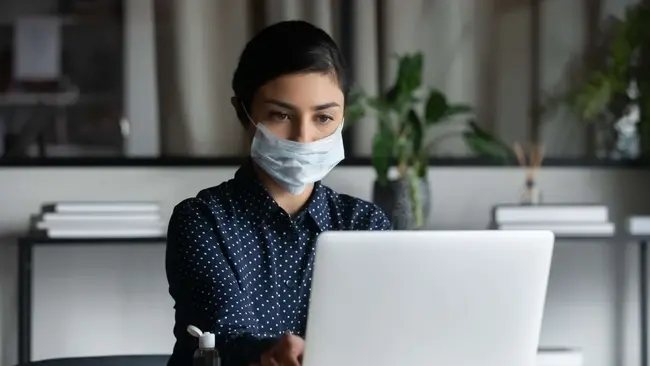For many organisations, employees working from home is no new thing. But since the outbreak of Covid-19 and the immediate decision by the government to restrict travel and to work from home where possible, the typical office worker had to quickly adapt to working from home as best they can.

Now the government is, once again, encouraging staff to work from home, many employers and employees have welcomed the flexibility that home working provides. Combined with the increase in productivity, many are reluctant to return to the old Monday to Friday 9-5 routine on a permanent basis.
It therefore appears, for the immediate future at least, home working as we now know it is here to stay for the vast majority of employees. But faced with a nation of lone workers, how must employers adapt to adequately safeguard their employees? Chris Potts, Marketing Director, ANT Telecom, explains.
Lone worker safeguarding
When lockdown restrictions were imposed, the normal health and safety checks and balances that would ordinarily take place to facilitate a person working from home were dispensed. The immediate danger was far greater than the potential risk of back ache by an employee setting up their workstation incorrectly, for example. After all, the move to working from home was only intended as a temporary measure. However, with businesses now having had several months to get used to the new way of operating – it is now important to carry out all those important checks. Employers need to make sure those that are working from home are doing so safely, and not doing anything that could impact their health in the short or long term.
There are of course a number of things to consider, but one that should not get overlooked is the fact that virtually everyone is now working alone. The risk to a home worker is fairly low as are those risks when working in the office. But at least everyone is together in the office and can react if someone falls ill suddenly. There will certainly be some people within the organisation that will feel perfectly safe working from home. But if something were to happen and no processes were in place to provide better protection, it’s not just the individual that would suffer the consequences – the business would too.
In many cases you would hope that the individual would be able to use the house phone or a mobile phone to call for help. But some incidents happen so suddenly that it just isn’t possible to get to the phone in time.
Team communication
The most common accidents that occur each year are slips, trips and falls. There’s an estimated 250,000 non-fatal accidents on stairs which are serious enough to merit a trip to A&E each year. Other similar incidents that could render the person unconscious include slipping over in the shower or on the way back from lunch in wintery icy conditions. With more people now working from home, that number is only likely to increase.
The advice from the HSE is that employers should provide supervision, education and training, as well as implementing enough control measures to protect the homeworker. Supervision should include pre-agreed intervals of regular contact between the worker and employer through phone calls, emails etc. Some may argue that these intervals should be once every hour whereas others would say once daily may be sufficient. The absolute minimum most seem to agree with is that it is an employers’ responsibility to know that an employee has at least started and finished their work safely.
In an office-based environment, companies would have this covered as if employees didn’t turn up by their usual start time someone would take notice and raise the alarm. With many employees now working from home, how would anyone know? Though perhaps employees may say they’re in touch with colleagues daily, how long would it take for you to raise the alarm if communication stopped? Minutes? Hours? In some cases it could be days. The checks that we once took for granted to ensure peoples’ safety are no longer in place – what do we now do to replace them?
Of course, the home worker may be protected somewhat by family members or house mates, but at some point even those members may return to work at least some of the time. What then? And how about those that live alone? Employers need to consider those that are more vulnerable e.g. staff that are pregnant, more elderly, have difficulty walking or have an existing health condition like diabetes or heart trouble.
When the onus is placed on managers and supervisors to continually monitor employees, it can become a burden and a distraction from their usual role. And when people are busy, this is one of the first manual processes to fall by the wayside. Some groups, especially those that feel vulnerable, would welcome a more robust process to ensure their safety.
Scenario planning
One way we can identify the best approach is to first think about how an investigation would play out if an incident was to happen. What are the questions that could be asked and where would the business be accountable? Such things could include PAT testing, if a worker was electrocuted at home and is an example of something that could have been avoided if certain procedures and advice were followed. They may also want to understand what time the incident took place and when help first arrived. If an incident happened first thing in the morning and was only discovered by a family member upon returning home in the evening, it would be hard to argue that the best method was in place.
By assessing hypothetical incidents, it is clear that companies would benefit from a solution that clearly shows that workers have at least started and ended their day safely. That way, if someone didn’t check-in in the morning, a process could start immediately at 9am to find out what’s happened, rather than waiting until a member of the family returns that evening or relying on someone internally raising the alarm. Similarly, if someone fails to log out at the end of the day, an alarm can be triggered. But some organisations or users may feel more comfortable with more regular check ins. An app-based solution enables the user to have more regular check-ins via a method that’s easy to use and not onerous on anyone. Moreover, with functionality that allows the user to quickly trigger an alert themselves in the event of an emergency, or automatically should they be rendered unconscious, all the lone worker risk bases are covered.
End-to-end processes
While the alarm triggering solutions are crucial for safeguarding, the process to resolve the incident is just as important. Users will not use the solution if they do not have full confidence their colleagues will help them when they need them most. Responding to each alarm is a fundamental part of the process and it’s important that users believe their colleagues have the tools to do this effectively.
Essentially, how each company sets up their response team structure is down to them. One company might decide that it is better to have five or six responders that are responsible for all company employees, others may prefer to have specific responders, like a line manager and deputy, for each employee. The response team can include family members and neighbours too.
Once an alarm is raised, it can be communicated to the appropriate response team on their desktop, laptop or mobile phones, with the details of the home worker, and when it was activated.
But if several responders are notified, confusion can occur as to who is responding to the situation. As such, a single member of the response team must take ownership to resolve the incident, replying to the alert message accordingly and then attempting to contact the worker. This can involve coordinating with a family member or neighbour to gain access to the property, alerting the emergency services and escalating the situation as necessary.
With a solution that also keeps a record of the alerts that have been activated and resolved, businesses can review where improvements can be made in future and also demonstrate the processes in place to the HSE, should they ever be investigated – safeguarding not just their employees, but the business as a whole.
Conclusion
Unsurprisingly with the rapid raise in home working, most businesses are unlikely to have adequate procedures in place to mitigate risks for all their staff working at home. Merely relying on the day-to-day business activity or the line managers' discretionary catch-up-call is simply not a robust enough system to protect all members of staff. And increasing current measures such as introducing more calls or online video meetings will only act as an expensive roll call and become a burden for certain employees.
An automated solution is far more effective and can incorporate all home workers. This enables the organisation to focus on its core business and helps to reduce stress and workload for managers and supervisory staff.







Comments ( 0 )